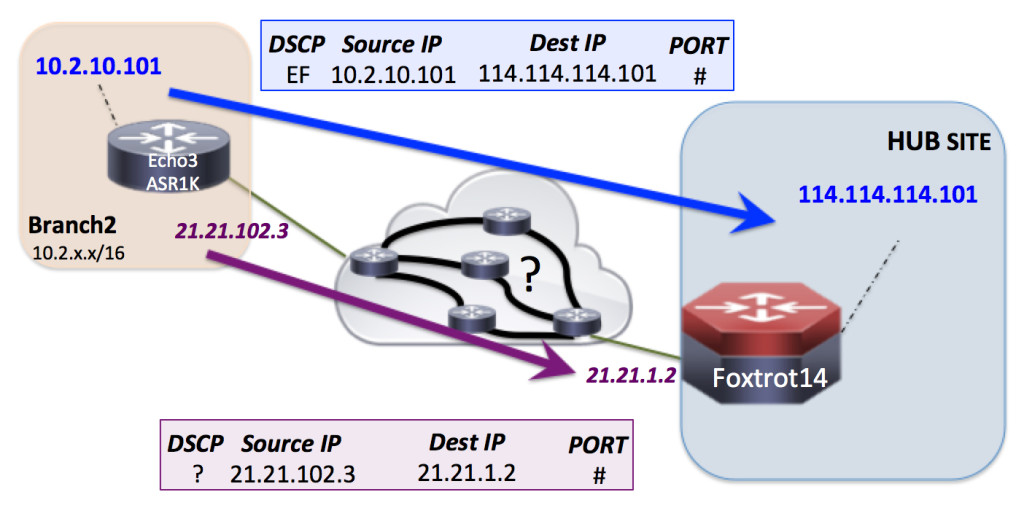Blessed by Gartner: Stretched VLANs Make Little Sense
One of my readers recently pointed me to a blog post written by Andrew Lerner from Gartner describing the drawbacks of stretched VLANs.
TL&DR: He’s saying more-or-less the same things I’ve been preaching for years. Now I can put Blessed by Gartner logo on my blog posts ;), and you can use the report to sway your CIO.
Read more ...Which Path in the WAN are those Business Critical Applications Taking?
“Learning about and avoiding impairments (delay, loss, jitter) along the path that business critical traffic takes.” That is what I wrote in my previous blog “IWAN’s Intelligent Path Control & Using Your Backup Link.” But how is that possible to do?
Thinking some type of probe? From where to where? Thinking the WAN edge links? But how do you know the path you send your probes over is the path that your business critical traffic is taking?
Let’s talk about what I mean by this by looking at an example.
In the above picture we have 2 sites with 1 host per site, and 1 WAN connection between the two.
- Branch2 w/ host 10.2.10.101
- Hub Site w/ host 114.114.114.101
- WAN connection w/ 21.21.102.3 on the Branch2 side and 21.21.1.2 on the Hub Site side.
Let’s say you check the health of the path between Branch2 and the Hub Site with some type of probe/IP SLA. You will be doing it from the 2 WAN IP addresses 21.21.102.3 and 21.21.1.2. Right? Continue reading
Slideshow: v0dgeball Adds a Dose of Action to VMworld
 A pre-VMworld tradition, v0dgeball is a charity dodgeball tournament that drew 16 teams eager to bean each other in the ankles.
A pre-VMworld tradition, v0dgeball is a charity dodgeball tournament that drew 16 teams eager to bean each other in the ankles.
I passed the CCIE Lab Exam in Routing and Switching v5!
Original content from Roger's CCIE Blog Tracking the journey towards getting the ultimate Cisco Certification. The Routing & Switching Lab Exam
Well the post that I have been dreaming of writing since the start of this blog is actually being written. I passed the CCIE Lab Exam in Routing and Switching v5 in Brussels last week and am now CCIE #50038 It has been a journey and as readers of this […]
Post taken from CCIE Blog
Original post I passed the CCIE Lab Exam in Routing and Switching v5!
Kernel bypass
In two previous posts we've discussed how to receive 1M UDP packets per second and how to reduce the round trip time. We did the experiments on Linux and the performance was very good considering it's a general purpose operating system.
Unfortunately the speed of vanilla Linux kernel networking is not sufficient for more specialized workloads. For example, here at CloudFlare, we are constantly dealing with large packet floods. Vanilla Linux can do only about 1M pps. This is not enough in our environment, especially since the network cards are capable of handling a much higher throughput. Modern 10Gbps NIC's can usually process at least 10M pps.
 CC BY 2.0 image by Tony Webster
CC BY 2.0 image by Tony Webster
It's apparent that the only way to squeeze more packets from our hardware is by working around the Linux kernel networking stack. This is called a "kernel bypass" and in this article we'll dig into various ways of achieving it.
The kernel is insufficient
Let's prepare a small experiment to convince you that working around Linux is indeed necessary. Let's see how many packets can be handled by the kernel under perfect conditions. Passing packets to userspace is costly, so instead let's try to drop Continue reading
Configuring ASAv as KVM Node
As promised earlier in my blog post about importing VIRL images within GNS3, here's one way to configure ASAv (9.4.1 here). I haveSee You in Bern on September 16th
TL;DR: Gabi Gerber from Data Center Interest Group Switzerland (DIGS) is organizing a day-long Data Center event on September 16th, and invited me (again) as the keynote speaker. Do drop by to discuss data center design and automation challenges.
Read more ...Open Source CloudRouter Goes to Production
If you have wondered why there isn't a open-source project for IP routing then you will be pleased to know that CloudRouter has announced that it is production ready.
The post Open Source CloudRouter Goes to Production appeared first on Packet Pushers.
How to permanently change qemu’s qcow2 image?
Of course you heard of qemu. Its a hypervisor used by UNetLab and GNS3 to integrate virtual routers like Alcatel-Lucent’s 7750 SR, Junipers vMX and Cisco’s XRv. And it is well-known that those virtual routers come in the form of qemu disk images with an odd [crayon-563410ebce426237947726-i/] extension. But how can we alter those disc images if we need,NOSHUT got twitter!
Hey fellows! I know some of you prefer to track new posts in twitter feed. For those of you I created noshut_ru twitter account where you will find all the updates and some reposts from networking gurus. Follow!robots.txt usage over the Alexa million
robots.txt usage over the Alexa million
If you ever had to deal with bots while running a site you will have at least at some point looked into robots.txt, a system that isn’t rea
HP Releases 6127XLG blade switch for HP Blade enclosure
HP has released the 6127XLG blade switch for the C7000 blade enclosure. This Comware7 based switch is the big brother of the 6125XLG, so while the 6125XLG supported 10G server access, the 6127XLG includes support for the 20G server access … Continue readingSDxCentral Weekly News Roundup — September 4, 2015
 Giddy up, y'all! AWS is looking to buy, while Gigamon and RSA team up. Find out more in this week's roundup.
Giddy up, y'all! AWS is looking to buy, while Gigamon and RSA team up. Find out more in this week's roundup.
Do 5th Graders Really Need Laptops?
I’m conflicted about the expansion of tech into education. Is another screen really going to enhance learning, or just make kids increasingly distracted?
The post Do 5th Graders Really Need Laptops? appeared first on Packet Pushers.
iPexpert’s Newest “CCIE Wall of Fame” Additions 9/04/2015
Please join us in congratulating the following iPexpert students who have passed their CCIE lab!
This Week’s CCIE Success Stories
- Eric Williamson, CCIE #49880 (Collaboration)
- Paul Raffles, CCIE #49941 (Data Center)
- Fabien Roulette, CCIE #49854 (Collaboration)
This Week’s Testimonial
Eric Williamson CCIE #49880 (Collaboration)
I would absolutely recommend IPexpert and Andy Vassar for CCIE Collaboration training. One of my favorite parts of the new blueprint change was that the rack rentals went to four hours and the labs increased but they were able to be done in smaller sections. As a person who travels on the road almost every week it was important to have a phone control/view option when coming in on a software VPN. This helped me to keep on track. Thank you Andy for helping me in so many instances, I will be eternally grateful.
Fabien Roulette CCIE #49854 (Collaboration)
Thank you very much for the quality of your books and pods on proctorlabs
We Want to Hear From You!
Have you passed your CCIE lab exam and used any of iPexpert’s self-study products, or attended a CCIE Bootcamp? If so, we’d like to add you to our CCIE Wall of Fame!
